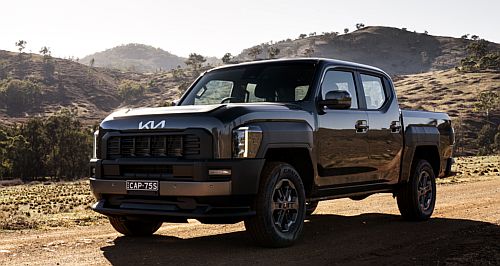Make / Model Search
News - Kia - TasmanKia reveals 10-year plan for Tasman faceliftsV6 engines ruled out, but plan for lower-CO2 engines and successful facelifts detailed1 Aug 2025 By TOM BAKER A DECADE of upgrades will keep the first-generation Kia Tasman in production until 2035, with rolling powertrain updates and visual facelifts locked in to support the Tasman’s long-term performance in an evolving regulatory and competitive landscape.
Underpinned by a comprehensive product planning strategy, the Tasman is expected to undergo two or three major facelifts across its lifecycle, anticipated around 2027, 2030, and 2033.
Each visual update is understood to be aligned to new or revised powertrain options aimed at maintaining customer interest and compliance with tightening Australian emissions regulations under the New Vehicle Emissions Standard (NVES), which legislates CO2 limits for new models out to 2029.
Kia Australia’s senior leadership team chief executive officer Damien Meredith, chief operating officer Dennis Piccoli, and general manager of product planning Roland Rivero confirmed the plan, which includes updates designed not only to reduce CO2 output, but potentially improve performance at the same time.
While preliminary engineering work for the Tasman explored the use of a six-cylinder engine (either the twin-turbo 272kW/510Nm 3.3-litre V6 from the defunct Stinger sports sedan, or a diesel six) Kia ruled out large powertrains for the Tasman on emissions grounds.
“Would we have liked to have seen the Stinger engine, a bi-turbo V6, (in Tasman)? It would have been pretty cool,” Mr Rivero told GoAuto.
“But under NVES, and all the other things we have to balance out, (a V6) doesn’t make sense from a feasibility perspective. The maths don’t work out.”
Despite the popularity of diesel V6 engines in competitors such as the Ford Ranger, which shares an optional 184kW/600Nm 3.0-litre ‘six with the related Volkswagen Amarok, Mr Rivero confirmed such a configuration was determined globally unviable for the Tasman project.
The Tasman’s sole launch powertrain is a 154kW/440Nm 2.2-litre four-cylinder diesel that produces 195-214g/km CO2 depending on variant.
It’s a ‘dirtier’ diesel than a Ranger’s 2.0-litre bi-turbo four-cylinder (189g/km in Wildtrak form), though the Ford/Volkswagen V6 utes emit more than a Tasman at about 222g/km. Ford wants to offset these numbers by dialling up sales of its Ranger plug-in hybrid (PHEV), which officially emits just 66g/km CO2.
Kia does not have the luxury of a PHEV version of the Tasman to pull its emissions profile downward, but unlike Ford, Kia has a growing range of battery electric (BEV) and hybrid (HEV) passenger cars and SUVs that the marque believes will offset Tasman emissions for its first couple of years.
“The (154kW/440Nm) 2.2 diesel engine is a solid engine. The gearing they have been able to do with Tasman is exceptional,” said Mr Meredith.
Mr Rivero noted that four-cylinder diesel engines continue to account for four in five ute sales nationally, though Kia’s research and development team in Korea is already exploring how to produce a hybrid Tasman that retains credible 3500kg towing capacity and solid payload.
“We don’t want to compromise on the capability requirements of the customer, but we’re not just going to sit back and relax on the powertrain options of Tasman,” added Mr Rivero.
Kia is closely monitoring the early performance of plug-in hybrid (PHEV) rivals such as the BYD Shark 6 and GWM Cannon Alpha, with Mr Meredith praising BYD’s early traction in the segment.
“They’ve got a lot of sales. I think (BYD) has done a great job hitting a slither of the segment as it has done before with other models. They’ve done it very, very well,” added Mr Meredith.
With new entrants and seismic product planning developments imposed by NVES, the ute segment is one to watch. Kia is targeting 20,000 sales per year for the Tasman in Australia; in the first half of 2025, Ford shifted 28,311 Rangers; BYD sold 10,424 Shark 6 PHEV utes in the same timeframe.
Mr Piccoli cautioned that the Shark 6 ran without a competitor until recently (with the arrival of the GWM Cannon Alpha and Ford Ranger PHEVs).
GoAuto understands that initial work has already been undertaken on Tasman BEV, though Kia is understood to have deferred development due to ongoing uncertainty surrounding BEV uptake generally.
Rather than rolling out major drivetrain changes for the Tasman as model year updates, Kia plans to time significant powertrain swaps with mid-cycle facelifts of the Tasman to generate renewed interest and maintain compliance with emissions targets.
Kia Australia has expressed an interest in bringing the Kia Tasman Weekender concept to Australia in production form at such a changeover point to provide a halo model with a wider track and enhanced proportions.
“I think it’s hard to suddenly put a (new) powertrain in place in 12 months, for example. I wouldn’t say it would be a running change. If we were to put a crystal-ball timeline, it would be the next (facelift),” continued Mr Rivero.
“(That would include) tweaks to additional powertrains in response to NVES, or there could be technologies like idle stop and go that lowers your CO2 footprint.”
Kia Australia aims to make a success of the Tasman, with two goals articulated: securing a second-generation version of the ute to enter production next decade, and bringing a Tasman 4WD to the Australian market.
“We’re going to constantly reveal what we need to do for Tasman to give it the longevity to see a second generation 10 years from now. It’s going to constantly evolve over the next 10 years,” added Mr Rivero.
Rivero added that recent examples of successful mid-life updates, such as those undertaken for the Sorento SUV and Toyota HiLux, highlight the effectiveness of facelifts when executed with meaningful upgrades.
 Read more |
Click to shareKia articlesResearch Kia Motor industry news |











Facebook Twitter Instagram